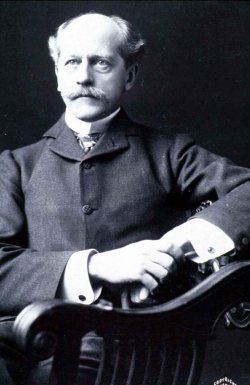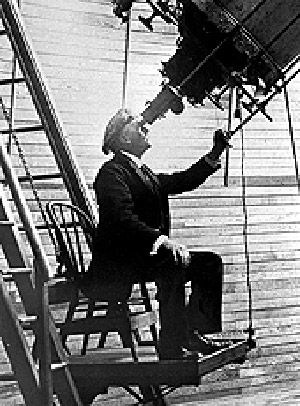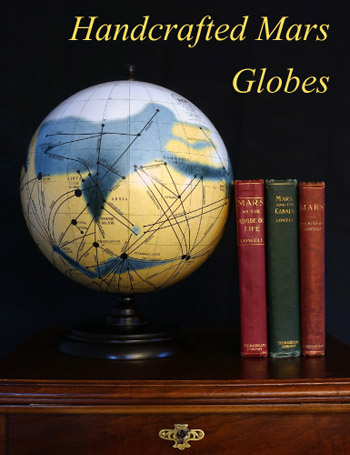Lowell, Percival (1855–1916)

Percival Lowell.

Percival Lowell sat at the 24-inch reflector at the Lowell Observatory.
Visit Mars globes.
Born into a wealthy and well-known Bostonian family, Percival Lowell gave no early indication of the obsession that would come to dominate his life and create an enduring romance involving extraterrestrial canals (see canals on Mars) and an advanced martian civilization (see life on Mars). At Harvard, where for 24 years his brother was president, he showed a talent for mathematics and even presented an astronomical address entitled "The Nebular Hypothesis". But following his graduation, he devoted the next 17 years to family business concerns and three extended stays in the Orient. He served as Foreign Secretary and Counselor to the first Korean diplomatic mission and, during his time in Korea and Japan, wrote four books on Eastern thought and culture. Then, for some reason which is not entirely clear, he caught the Mars bug. Perhaps he had been inspired by reading Flammarion's popular treatise on the planet. Or, it may have been Schiaparelli's work that influenced him directly. Certainly, as early as 1890, he had begun to correspond with William Pickering on the subject. By the beginning of 1894 he had determined to become actively involved in the study of Mars and made urgent preparations in order not to miss the favorable opposition which was due later that year. He stated his goal in an address to the Boston Scientific Society on 22 May 1894:
This may be put popularly as an investigation into the condition of life on other worlds, including last but not least their habitability by beings like [or] unlike man... there is strong reason to believe that we are on the eve of pretty definite discovery in the matter.
As to the nature of Schiaparelli's canali he had no doubt: "... in them we are looking upon the result of the work of some sort of intelligent beings ..."
Together with Pickering and Andrew Douglass, he set up two sizable telescopes (a 12-inch and an 18-inch refractor), both on loan, at a hastily erected observatory in Flagstaff, Arizona (see Lowell Observatory). By Aug, he was sketching canals and other intricate features on the martian surface, including dark spots where the canals intersected. Pickering had first reported seeing these spots, which he referred to as "lakes" in 1892. Now, Lowell saw them, too, and renamed them "oases". In his mind, they were the tracts of vegetation (see vegetation on Mars) irrigated by meltwater brought by the canals from the poles. After seeing Mars at just one opposition, Lowell launched a publicity blitzkrieg to announce his theory about the grand hydrological schemes of an alien race. Numerous articles, lectures, and a book, Mars,1 by him in 1895 were greeted with fascination by the public and extreme skepticism, if not outright derision, by most astronomers. When asked which books he had enjoyed reading recently, British astronomer Norman Lockyer replied, "Mars by Percival Lowell, Sentimental Tommy by J. M. Barrie. (No Time for Reading Seriously)." And here is James Keeler, who became Director of the Lick Observatory in California, speaking at the dedication ceremony of the Yerkes Observatory at Williams Bay, Wisconsin in 1897:
It is to be regretted that the habitability of the planets, a subject of which astronomers profess to know little, has been chosen as a theme for exploitation by the romancer, to whom the step from habitability to inhabitants is a very short one. The result of his ingenuity is that fact and fantasy become inextricably tangled in the mind of the layman, who learns to regard communication with inhabitants of Mars as a project deserving serious consideration ... and who does not know that it is condemned as a vagary by the very men whose labors have excited the imagination of the novelist.
Even as Lowell's theory began to take shape in the public consciousness, however, it was being undermined by the results of others during the 1894 opposition. At the Lick Observatory, William Campbell used a new spectroscope to search for water vapor in the martian atmosphere – and found none, contradicting earlier results. Meanwhile, his colleague at Lick, Edward Barnard, one of the most respected observers of his day, scrutinized the martian surface with the giant 36-in refractor but failed to see any sign of straight narrow lines. Lowell countered by arguing that large telescopes were ill-suited to planetary observation and, in any case, much depended on the seeing conditions which, he asserted, at Flagstaff were among the best available. Lowell claimed that the canals only appeared to him from time to time – rare and precious visions – when the seeing was excellent. Then the mystery markings would suddenly stand out, he said: "like the lines in a fine steel etching." Also in 1894, Edward Maunder, in England, suggested that the canals might be optical illusions and did some experiments with model disks to prove his point. But Lowell would have none of it and pressed on, single-mindedly, in his pursuit of proof that the network of waterways was both real and intelligently constructed. As many as 500 canals eventually filled his martian maps. He wrote:
Irrigation, unscientifically conducted, would not give us such truly wonderful mathematical fitness ... A mind of no mean order would seem to have presided over the system we see - a mind certainly of considerably more comprehensiveness than that which presides over the various departments of our own public works. Party politics, at all events, have had no part in them; for the system is planet-wide.
From lines to canals to canal-builders to world government! Lowell published two further books, Mars and Its Canals2 (1906) and Mars as the Abode of Life3 (1908), and continued to argue vociferously for the existence of a canal network until his death in 1916.
References
1. Lowell, Percival. Mars. New York: Houghton-Mifflin (1895).
2. Lowell, Percival. Mars and Its Canals. New York: Macmillan
(1906).
3. Lowell, Percival. Mars as the Abode of Life. New York: Macmillan
(1910).


